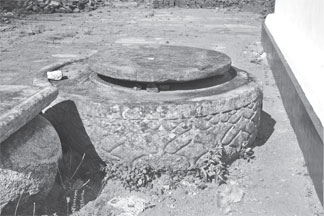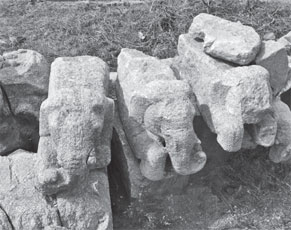|
The largest stupa in the world:
Abhayagiri monastery
 Hidden under a million of steel pipes, Abhayagiri Stupa stands
majestically at a 235 hectare land at the northern part of ancient
Anuradhapura. Built during the second reign of King Vattagamini Abhaya
in the first century BC, it has been under construction for a very long
time. Hidden under a million of steel pipes, Abhayagiri Stupa stands
majestically at a 235 hectare land at the northern part of ancient
Anuradhapura. Built during the second reign of King Vattagamini Abhaya
in the first century BC, it has been under construction for a very long
time.
For many years in the recent past people gathered and volunteered to
renovate the Stupa.
Abhayagiri monastery was built especially for a group of monks who
were expelled from the main monastery of that era, Maha Vihara. The
resident bhikkhus launched a new sect known as Mahayana Buddhism. Soon
after they introduced the new concept, the fame of the monastery and the
teachings spread across and beyond the country. They attracted
scientists and devotees from countries such as India, China, and
Indonesia. However, the history of the monastery was unknown and the
records were not properly kept.
 |
|
Scattered ruins |
|

Decorated pillar |
The chronicle Mahavamsa was written at Maha Vihara, the rival
monastery of Abhayagiri. Therefore, the author of Mahavamsa had not
taken any effort to give a detailed account of the Abhayagiri.
Fa-Hsien, the Chinese Buddhist monk who travelled in many Buddhist
countries had once lived at Abhayagiri for nearly two years. He says
that around 5,000 bhikkhus resided here at that time. The conservation
project carried out by the Cultural triangle, had found a stone through
with the capacity of 5000 alm bowls, indicating that it was used to
store boiled rice.
Differences
The floor plan of the cafeteria of the complex is said to be somewhat
different from those found in other monasteries in Anuradhapura. Built
with two courtyards, paved and well drained, the builders had ensured
adequate light and ventilation of the building. This has been expanded
several times. Archaeologists found ruins belonging to different
cultural phases and a stone inscription from the first century B. C.
Fresh water was supplied and waste water drained by a system of
underground conduit pipes. In addition to these, a stone sundial had
been used to ensure that the mid-day meal was served before noon,
Various types of grinding stones and hearths had been found at the
excavations.
Abhayagiri Stupa built by King Gajabahu to a height of 115 m is
considered as the largest Stupa in the world, only a little shorter than
Jethawanarama, which is 120 m. It is said that the Stupa is built over
the footprint of the Buddha and it is one of the eight great places of
veneration in Anuradhapura. The Stupa has an inner terrace and an outer
terrace enclosed by walls.
|

Abhayagiri Stupa |
The outer terrace was sprinkled with sand,
while the inner terrace is paved with stone. The rain-water falling on
the vast stretch of land was drained into four ponds built near the
Stupa grounds. Today stripped parts of the outer casing of the stupa is
covered by vegetation.
Solid brickwork
Built of solid brickwork laid in a butter clay mortar, the dome
contains small, inaccessible chambers or garba concealed in its
interior. The superstructure above the dome consists of the massive
rectangular cube of the hataraskotuva surmounted by the circular
devatakotuva and the badly damaged spire.
King Parakramabahu 1 is said
to have renovated the Stupa last. Since the construction work is still
going on, there are ruins of the vahalkada, scattered behind the image
house near the stupa.
Abhayagiri Vihara complex has other stupas as well. Lankarama Stupa,
which originally had a conical roof covering, is one such stupa.
Officials have identified as Silasobbhakandaka Chetiya built by King
Valagamba.
Another tall brick structure, situated in Vahadu-mula to the
west of the Elephant Pond, was previously thought to be a library
building. However, it also turned out to be a stupa. Another situated
close to the Ratnaprasada, is the popularly known Indikatu Seya.
The
last two stupas are very similar in their design to the Naka Vehera. The
Indikatusaye, or Needle Stupa, is an example of the creativity of the
ancient Sinhalese in planning and erecting buildings in harmony with the
surrounding landscape.
 |
 |
| Lotus pedestal |
More stone ruins |
|

